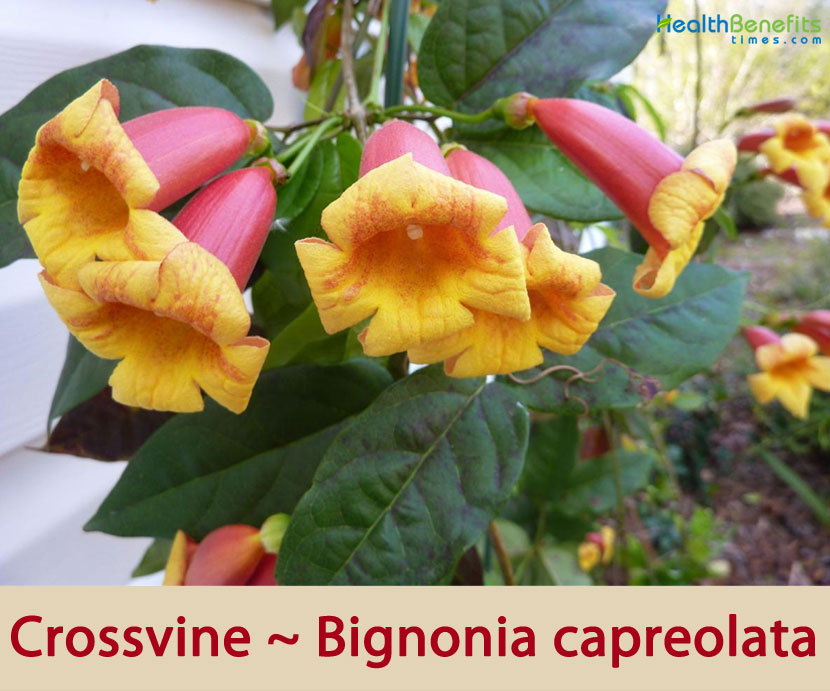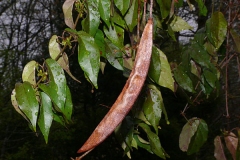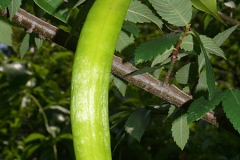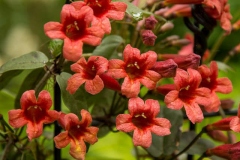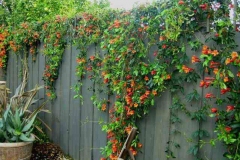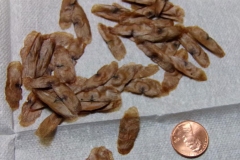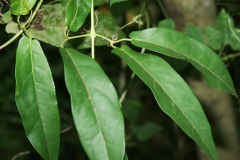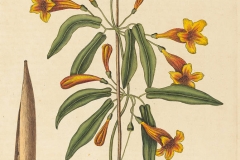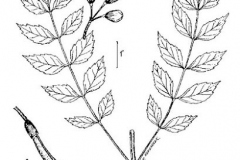| Crossvine Quick Facts | |
|---|---|
| Name: | Crossvine |
| Scientific Name: | Bignonia capreolata |
| Origin | United States in the northeastern, north central, south central and southeastern regions. It is found from southern Ontario, south to Florida, west to Texas and Illinois |
| Colors | Initially green turning to brown as they mature |
| Shapes | Pod-like woody seed capsule that is approximately 6 inches long and 1 inch wide which mature in late summer |
| Health benefits | Support rheumatism, edema, headaches, diphtheria and also purify blood |
| Name | Crossvine |
|---|---|
| Scientific Name | Bignonia capreolata |
| Native | United States in the northeastern, north central, south central, and southeastern regions. It is found from southern Ontario, south to Florida, west to Texas and Illinois |
| Common Names | Quartervine, Crossvine, Trumpet Flower |
| Name in Other Languages | Afrikaans: Kruis wingerdstok Albanian: Hardhi kryq Amharic: Weyini teshageru (ወይን ተሻገሩ) Arabic: Eabr karama (عبر كرمة) Armenian: Khach’i vort’ (խաչի որթ) Azerbaijani: Carpaz üzüm Bengali: Krasa latā (ক্রস লতা) Bulgarian: Krŭstosana loza (кръстосана лоза) Burmese: Hc pyit nwalpain ko hpyat (စပျစ်နွယ်ပင်ကိုဖြတ်) Chinese: Héng màn (横蔓) Croatian: Križna loza Czech: Kříž révy Danish: Kryds vin Dutch: Kruis wijnstok English: Quartervine, Crossvine, Trumpet Flower Esperanto: Kruci vinberujon Estonian: Rist viinapuu Filipino: Tumawid ng puno ng ubas Finnish: Rajat viiniköynnös French: Croix de vigne, bignone orange, bignone à vrilles Georgian: Jvari vazi (ჯვარი ვაზი) German: Kreuzrebe, Kreuzranke Greek: Stavrós ampélou (σταυρός αμπέλου) Gujarati: Krōsa vēlō (ક્રોસ વેલો) Hausa: Gciye itacen inabi Hebrew: חוצה גפן פרח, ביגנוניית הקנוקנות Hindi: Bel ko paar karen (बेल को पार करें) Hungarian: Keresztező szőlő Icelandic: Kross vínviður Indonesian: Anggur silang Irish: Fíniúna tras Italian: Croce di vite, bignonia aranciata, tetrafilla Japanese: Tsurutsuru (つるつる), Tsuriganekazura (ツリガネカズラ) Javanese: Nyebrang Vine Kannada: Aḍḍa baḷḷi (ಅಡ್ಡ ಬಳ್ಳಿ) Kazakh: Kross jüzim (кросс жүзім) Korean: Keuloseu deong-gul (크로스 덩굴) Kurdish: Tîrêja xaçê Lao: Kham kheu (ຂ້າມເຄືອ) Latin: Vinea crucis Latvian: Krustu vīnogulāju Lithuanian: Kirsti vynmedį Macedonian: Krstot loz (крстот лоз) Malagasy: Miampita voaloboka Malay: Menyeberangi pokok anggur Malayalam: Krēās muntirivaḷḷi (ക്രോസ് മുന്തിരിവള്ളി) Maltese: Qasma tad-dwieli Marathi: Kros velee (क्रॉस वेली) Mongolian: Usan üzmiin usan üzmiin mod (усан үзмийн усан үзмийн мод) Nepali: Krasa dacha (क्रस दाख) Norwegian: Kryss vintreet Oriya: ଦ୍ରାକ୍ଷାଲତା Pashto: کراس تاک Persian: تاک متقاطع Polish: Krzyż winorośli Portuguese: Videira cruzada Punjabi: Karāsa vela (ਕਰਾਸ ਵੇਲ) Romanian: Cruce de viță de vie Russian: Krest loza (крест лоза) Serbian: Ukrštena loza (укрштена лоза) Sindhi: ڪراس وڻ Sinhala: Haras midi (හරස් මිදි) Slovenian: Križna trta Spanish: Vid cruzada Sudanese: Nyebrang vine Swedish: Kors vinstock Tajik: Tok az saliʙ (ток аз салиб) Tamil: Kuṟukku koṭi (குறுக்கு கொடி) Telugu: Krās vain (క్రాస్ వైన్) Thai: K̄ĥām t̄heāwạly̒ (ข้ามเถาวัลย์) Turkish: Capraz asma Ukrainian: Poperechna loza (поперечна лоза) Urdu: کراس بیل Uzbek: Uzum uzum Vietnamese: Cây nho chéo Welsh: Croes winwydden Zulu: Umvini wesiphambano |
| Plant Growth Habit | Beautiful semi-evergreen, perennial, climbing, woody vine |
| Growing Climates | Fences, arbors, walls, pillars or large trellises, as a groundcover, rich forests, swamps, along roadsides, fencerows, bottomland forests, floodplains, riverbanks, streamsides; less often in seasonally inundated swamps, wet thickets, and more mesic, upland forests |
| Soil | Prefers full sun and moist, acidic, well-drained soils for best flowering. It is adaptable to other soil conditions, including poorly drained soils, once established and it can do well in low light levels. It is drought tolerant |
| Plant Size | About 50 or more feet long |
| Stem | Squarish and reddish-purple |
| Bark | Grayish brown and scaly |
| Leaf | Leaves are semi evergreen, opposite, pinnately compound, with two basal, leaflets with a branched tendril between the two leaves. Leaflets are 6-15 cm long, 2-7 cm wide and have smooth edges (entire), narrowly tapered tips (acuminate), and a notch at the base that makes them heart-shaped (cordate). |
| Flowering season | From mid-March to mid-June |
| Flower | Flowers are bell-shaped with orange on the outside and yellow inside, have 5 irregular lobes, and are 4-5 cm long |
| Fruit Shape & Size | Pod-like woody seed capsule that is approximately 6 inches long and 1 inch wide which mature in late summer and persist into fall |
| Fruit Color | Initially green turning to brown as they mature |
| Seed | Capsule contains several rows of winged seed |
| Propagation | By seeds, root cuttings and soft wood cuttings |
Plant Description
Crossvine is a beautiful, vigorous, semi-evergreen, perennial, climbing, woody vine that normally grows about 50 or more feet long and uses its tendrils to attach its self to trees or fences or through the tops of thickets. Tubers can grow to 10 cm in diameter. The stem is squarish and reddish-purple. The bark is grayish brown and scaly. When cut in cross section, the phloem forms a distinct “X” within the stem. The plant climbs by tendrils. The tips of the tendril have adhesive disks that allow the vine to attach itself to a tree or other available support such as a fence. The plant is found growing in fences, arbors, walls, pillars or large trellises, as a groundcover, rich forests, swamps, along roadsides, fencerows, bottomland forests, floodplains, riverbanks, stream sides; less often in seasonally inundated swamps, wet thickets, and more mesic, upland forests. The plant prefers full sun and moist, acidic, well-drained soils for best flowering. It is adaptable to other soil conditions, including poorly drained soils, once established and it can do well in low light levels. It is drought tolerant. Crossvine can spread aggressively through stolons and may need to be managed in garden or domestic settings.
Leaves
Leaves are semi evergreen, opposite, pinnately compound, with two basal, leaflets with a branched tendril between the two leaves. Leaflets are 6-15 cm long, 2-7 cm wide and have smooth edges (entire), narrowly tapered tips (acuminate), and a notch at the base that makes them heart-shaped (cordate). The foliage turns from a lustrous green in the growing season to a reddish purple in the winter. Buds are reddish-purple and less than 1 cm long.
| Leaf Arrangement | Opposite |
| Leaf Venation | Brachidodrome |
| Leaf Persistence | Evergreen |
| Leaf Type | Even Pinnately compound |
| Leaf Blade | 5 – 10 cm |
| Leaf Shape | Lanceolate |
| Leaf Margins | Entire |
| Leaf Textures | Waxy |
| Leaf Scent | No Fragrance |
| Color(growing season) | Green |
| Color(changing season) | Green |
Flowers
The flowers occur in clusters of two to five in the axils of the leaves. The flowers are trumpet shaped having 5 irregular lobes, and are 4-5 cm long. Flowers are commonly orange on the outside and yellow on the inside; rarely the flowers are yellow or a deep orange-red on the outside. Flowering occurs from mid-spring to late summer. The flowers are pollinated by the ruby-throated hummingbird and ants are commonly seen stealing nectar from the flowers.
| Flower Showiness | True |
| Flower Size Range | 3 – 7 |
| Flower Type | Solitary |
| Flower Sexuality | Monoecious (Bisexual) |
| Flower Scent | Pleasant |
| Flower Color | Yellow, Orange, Red |
| Seasons | Spring, Summer |
Fruit
Fertile flowers are followed by pod-like woody seed capsule that is approximately 6 inches long and 1 inch wide which mature in late summer and persist into fall. Fruits are initially green turning to brown as they mature. Each capsule contains several rows of winged seed. Crossvine is often available from nurseries. Several horticultural selections are available with different colored flowers.
| Fruit Type | Capsule |
| Fruit Showiness | False |
| Fruit Size Range | 3 – 7 |
| Fruit Colors | Brown |
| Seasons | Spring, Summer |
Traditional uses and benefits of Crossvine
- Native Americans used crossvine as a remedy for numerous health ailments.
- An infusion of leaves was used to purify blood.
- Decoctions of leaves were used for rheumatism.
- Decoctions of mashed bark were used to alleviate edema and headaches.
- Individuals with diphtheria gargled a mashed root infusion.
- Leaf was used by the Cherokee as a blood purifier or alterative herb.
- The Koasati used the leaf for rheumatism and the bark was also used in baths as a remedy for headaches.
Other Facts
- The showy, fragrant flowers and unique leaves of crossvine make this plant appropriate for some gardening and landscaping needs.
- The tubular flowers and large quantities of nectar produced by crossvine are attractants for hummingbirds and butterflies.
- The best time to harvest crossvine seeds is in late summer when their pods have browned.
- Once harvested the seeds can be stored for planting at a later day.
- In the 18th century, it was considered to be a key ingredient in beer and other drinks that were used to purify the blood. There is no conclusive evidence of this.
References:
https://www.itis.gov/servlet/SingleRpt/SingleRpt?search_topic=TSN&search_value=34307#null
https://npgsweb.ars-grin.gov/gringlobal/taxon/taxonomydetail?id=105186
https://www.missouribotanicalgarden.org/PlantFinder/PlantFinderDetails.aspx?kempercode=w830
https://plants.usda.gov/DocumentLibrary/plantguide/pdf/pg_bica.pdf
https://www.fs.fed.us/wildflowers/plant-of-the-week/Bignonia_capreolata.shtml
https://aggie-horticulture.tamu.edu/syllabi/308/Lists/Fourth%20Edition/Bignoniacapreolata.pdf
https://gd.eppo.int/taxon/BIGCA
http://www.theplantlist.org/tpl1.1/record/kew-319861
https://en.wikipedia.org/wiki/Bignonia_capreolata
https://plants.usda.gov/home/plantProfile?symbol=BICA


